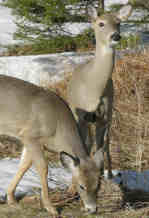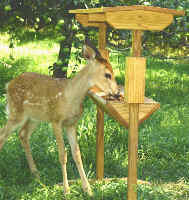All Rights within this web site and its related products are Copyrighted and Reserved by:
The Hurley-Byrd Bird Feeder Co.
Hurley-Byrd, LLC
462 Williams Cross Way
Fairmont, West Virginia 26554
Toll free: 877-363-0199
© 2002 - 2017
Feeding Deer Safely and Successfully
We are often asked how to feed deer and or how to set up feeders successfully.
In the past the only deer feeders available were the hunter or sportsman style feeders with electronic
motors and spinners throwing feed onto the ground. The Hurley-Byrd Deer Feeder is a great departure
from the old way of feeding deer and we want you to do it right, safely and successfully.
Read the article below written by Hurley-Byrd's owner, Peter Hurley, for
a good overview on enjoying this wonderful hobby.
When finished reading, view our high quality deer feeders and set up your own feeding station today.
Feeding White-tailed Deer (Odocoileus virginianus)
We handcraft the one and only, Hurley-Byrd Deer Feeder. It is one of our more popular feeders and for good reason. The fun and joy of watching deer is like no other. To have these beautiful creatures grace your home regularly adds a whole new dimension to your wildlife feeding sanctuary and doing so with a Hurley-Byrd Deer Feeder could not be easier.
Since our deer feeders are such a popular item and we receive so many questions,
I wish to spotlight The White-tailed Deer and offer some feeding tips to get you started.
Keep in mind, all deer use Hurley-Byrd feeders. This article will also address Black-tailed Deer and even Moose and Elk to a degree. The feeding activities of all deer are very similar.
White-tails are now the most wide spread deer in North America and it is directly
due to its ability to adapt and survive. It is found from the least humanly populated regions of
this continent to city parks teaming with our society’s hustle and bustle. Why, might you ask,
is the reason there are so many white-tails? It’s relatively simple. The White-tail has a tremendous
ability to adapt and survive. It will eat nearly anything, when needed, has fabulous senses
including the capability to spot small movements, its incredible hearing, and their sense of smell
equals that of a Bloodhound. But, in my years of observation, it is the White-tails awesome
athletic capabilities which allow it to escape dangers. It can go from zero to full speed faster
than any sports car made today, can leap horizontally eight to ten body lengths and jump
over twelve foot fences when required. White-tails are extremely tuned into their environment
and if you have had the pleasure of watching a group of deer at your deer feeder, you have
probably noticed they are always on guard. I call it their “Twitchy Nature” and I mean it.
Watch for a while and you’ll see them snap their heads or ears up, back, to the
side in a constant effort to monitor their environment. At the first sign of any
trouble, they are gone like a lightning bolt.
All of us love deer and many people enjoy attracting them to their yards but many do not
know how to do it well or at all. We receive many requests in regard to deer feeding and tips
to do so properly. To begin with, feeding deer is very simple. Their sense of smell will direct them
right to your feeder. When other food sources are becoming scarce, they will follow the
scent of good quality feed over long distances. Once they have found it, they will be
more than happy to stay around as long as there’s a fairly consistent supply.
There are various aspects of feeding deer that need to be addressed before
setting out a feeder. First and foremost. Deer are beautiful creatures and look to be
friendly, cuddly and approachable. This is very far from the fact of the matter. Deer can become
aggressive, although very rarely, for many reasons and we advise you keep your distance and do
not approach them for any reason. If you find a wounded deer, or any wild or domestic
animal, call your local wildlife control organization and do not approach the animal.
Any wounded animal is potentially very dangerous.
In order to feed deer properly and safely, pick a location away from your home with
a good viewing area. Do not set your feeder near a doorway or any other area that is frequented
by people or pets. If someone walks around a corner or through a doorway and comes face to
face with a deer, that deer needs to make a decision. It will go into one of two modes, flight or
fight. It prefers to flee and usually does but if it feels it cannot, it might decide to fight. Keep
your feeders away from any area where people may come into close contact.
With that being said, feeding deer is a wonderful hobby and one that can be done safely
and enjoyably. Once you have picked a safe location for your feeder, it is time to feed. We
highly recommend whole shelled corn (dried corn kernels that have been stripped from the cob
as a whole seed) as the staple food. It is a high protein feed, readily available and is the least
expensive to buy. Most importantly, it remains edible for many days under high moisture
conditions. When you start looking for suitable deer feed, you will find many types available on
the market. Some are excellent and some are not. We are often asked about commercial
deer chows. Deer chow is a manufactured, pelletized product utilizing a mix of various feed
types and may contain animal remnant by-products from slaughterhouses or the like.
If these by-products are not processed correctly they may contain various diseases that could
be introduced to the deer population through your feeding activity. Please do not use
deer chows unless you are positive they are tested safe.
Another issue with deer chow, and my personal dislike for them, is their inability to
remain palatable to your wildlife once they have gather moisture. Deer chow has no resistance
to water and even humidity will render it worthless. Any rain, melting snow or the like will “puff” the
chow into a mass of sloop. Think of a bowl of bran type cereal. By the time you have reached
the bottom of the bowl, the cereal is mush. This is deer chow when it gets wet and your deer
WILL NOT eat it. You have now wasted money on an expensive product and it must be discarded.
Whole shelled corn is by far a superior food type. The encased kernel of corn protects itself from
moisture and will remain edible for many days, wet or dry. Some people use cracked corn
in hopes of feeding their turkeys or other large birds such as Crows, Blue Jays and Cardinals.
All of these birds love my own deer feeder and use it regularly. Because of this, I throw a
few handfuls of sunflower seeds into the trough too. This encourages the birds to enjoy
the feeder and I gain more pleasure from the feeder itself. Using cracked corn is a great
idea as long as the feed is consumed quickly, within a day or so. Since the kernel, or
pericarp (outer shell of the seed) is “cracked” open, it losses it’s capability to protect itself
from moisture. When exposed to wetness, it too will absorb water and my not be eaten by
your deer. Turkeys have no problem with it though and if you have a good
population of them, they will readily feed from your deer feeder.
The MOST important rule of feeding deer is to offer one type of feed consistently.
Deer are ruminants, just like cows, and to properly digest their foods they develop a
bacterium in their stomachs to begin the digestive process. Many unaware people start
feeding their deer when the weather gets very cold or after other food sources are gone.
This is a nice gesture but it takes many days for deer to produce the bacteria. Hence, your
offering fills their bellies but they get little if any actual nutritional value. No matter when you start
feeding, keep the same base food type available throughout the year or season.
Once your deer have built up the appropriate bacteria, corn will become a premium
food source. Its high levels of protein and complex sugars will do wonders in sustaining
them through the hard months. You will find scads of articles on-line stating the idea
of feeding deer corn is worthless. They state deer cannot digest corn. That is absolutely
incorrect. To prove it, search for information regarding the process of fattening beef cows
before slaughter and you will find the number one product used is corn. Deer, being bovines
like all cows, can positively digest corn as long as you follow the information noted above.
Why feed deer? Besides the obvious reasons of our own enjoyment, all deer receiving
a good supply of nutrition will grow to be their biggest and healthiest. Bucks grow their
largest antlers when supplied with good feeds and nutrients from very early spring through
early fall. Doe Deer who receive proper nutrition throughout winter will produce the healthiest
fawns in late spring. Most Does carry two fawns and it takes a lot of energy to grow them in a
healthy manner. One of the most enjoyable aspects of feeding deer through winter is the Does
will more than likely bring their babies in late spring. Of all the nature moments, there is no better
wildlife treat than watching a pair of or groups of baby deer feeding, playing and frolicking
around your yard. They chase each other, kick up their heels and bounce around the
yard like children overdosed on sugar. It’s one of my most awaited wildlife moments
of the whole year and I guarantee it will become one of yours too.
Pick out a new deer feeder today and add a whole new dimension of wildlife feeding to your yard.
If you have questions or comments, please write or call us. We love wildlife and
will help you feed them correctly now and for years to come.
Shop by:
Hurley Byrd's Festival of Feeders
Pick Your Exact Feeder Exclusively on eBay
Hurley Byrd Does it Differently, Very Differently:
We handcraft each and every feeder we sell. Starting with our own designs, producing OUR OWN Lumbers and assembling your feeders with
real screws throughout. We then protect each feeder with a beautiful penetrating oil finish so they last for many years. We take pride in our service, too.
From the moment you first interact with us, whether on our website or on the phone, to the delivery of your feeders and gifts and everything in between.
We want to make owning and gift giving easy for you. So whether it's a simple thank you, a unique deer feeder gift a whole
feeding station for you and your family, choose Hurley-Byrd and see the difference our feeders really make.
All Rights within this website and its related
products are Copyrighted and Reserved by:
Hurley Byrd Wildlife Feeders
462 Williams Crossroads Way
Fairmont, West Virginia 26554
Telephone: 877-363-0199
© 2002 - 2019





